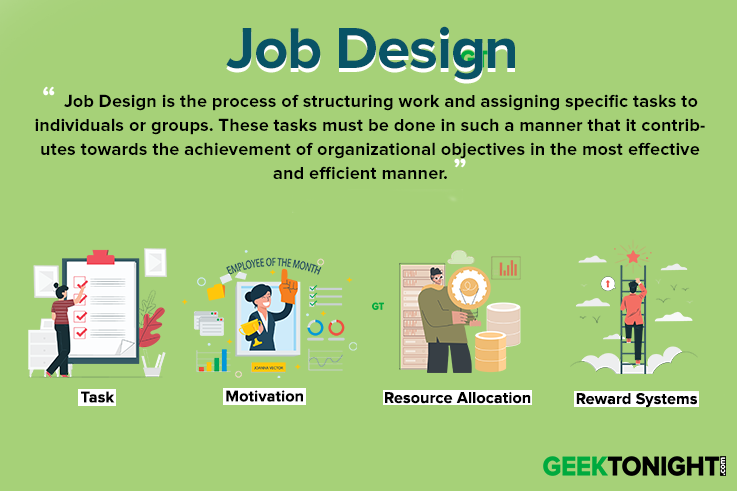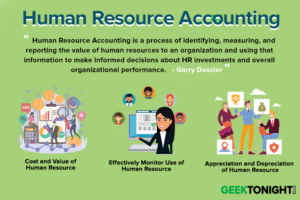What is Job Design?
Job Design is the process of structuring work and assigning specific tasks to individuals or groups. These tasks must be done in such a manner that it contributes towards the achievement of organizational objectives in the most effective and efficient manner.
In other words, job design is regarded as an effort to organize and structure tasks, duties and responsibilities into a unit of work to achieve certain objectives.

Table of Content
Job design determines the responsibility that has to be handed over to an employee, the authority that the employee enjoys for that responsibility. It also determines the decision making that has to be done by the employee and his satisfaction and productivity from the job.
Effective job design is not an easy process. It involves a complex process that focuses on many important issues like organizational goals and objectives, employee aspiration, work environment and performance standards etc.
The major role in job design is performed by the line managers as they understand the work process better. Job design basically involves three major steps which are as follows:
- The specification of individual tasks.
- The specification of the method or procedure for the performance of the task.
- The combination of tasks into specific jobs to be assigned to individual employees.
Job Design Definition
According to Armstrong, Job design can be defined as “the specification of the contents, methods, and relationships of jobs in order to satisfy technological and organizational requirements as well as the social and personal requirements of the job holder.”
Job Design “is the functions of arranging task, duties and responsibilities into an organizational unit of work” (Ali and Aroosiya, 2012)
Job design refers to the process of defining the way work will be performed and the tasks that will be required in a given job. It involves identifying the specific responsibilities, duties, and requirements of a job, and establishing a framework for how the work will be organized and completed. – Society for Human Resource Management (SHRM)
Job design is the process of specifying the content and method of work tasks in order to satisfy both the requirements of the job and the needs of the people who perform the job. It involves determining what tasks need to be done, how they will be done, and who will do them. – Gary Dessler, author of “Human Resource Management”
Elements of Job Design
- Task: The set of responsibilities that employees are required to complete within a specific time frame.
- Motivation: Job design should incorporate elements that enhance employee motivation towards job performance.
- Resource Allocation: Effective and efficient allocation of company resources to specific job roles can influence innovation and should therefore be a crucial consideration in job design.
- Reward Systems: Incorporating both monetary and non-monetary reward systems into job design can serve as a motivator for employees to enhance their job performance.
Factors Affecting Job Design
A well-designed job is more productive as well as satisfying for the job incumbent but there are many factors that affect the design of the job. Broadly these factors can be categorized into three major heads:
Organizational Factors
Organizational factor include:
Characteristics of Task
Job design involves assembling ofa number of tasks into a job or a group of job. An employee may perform one task which may involve many interrelated elements or functions. These functions are handled by a team or strung along an assembly line. Individuals may carry out a variety of connected tasks with a number of functions for a complex job.
In other words, the complexity of the job depends upon the number and variety of tasks to be carried out, or the scope of decisions that have to made or the higher degree of difficulty in measuring the result of the decision taken. planning, executing and controlling is considered as an important element for each task and an ideal job design integrates all these elements in an effective manner.
Work Flow
The nature of the product or service offered influences the work flow in the organization. The product or service gives an indication about the sequence and balance between jobs if the work has to be done in an efficient manner.
Ergonomics
It is concerned with designing and shaping the jobs in such a manner that it suits the physical abilities of the individual who has to perform the job effectively. It creates a balance between the physical abilities and job demands. Ergonomics do not disturb the nature of the job but only bring changes in the location of tools, switches and other facilities to make it more comfortable for handling.
Work Practices
These are regarded as the set ways of performing job or work. The work practices depend upon traditional ways or it is influenced by consensus of employees. The HR department is bound to follow these work practices and its flexibility to design a job is limited.
Environmental Factors
The external or environmental factors that affect the job design are:
- Employee Abilities and Availability
- Social and Cultural Expectation
- Behavioral Factors
- Feedback
- Autonomy
- Variety
Employee Abilities and Availability
Efficiency in job can only be achieved when there is an availability of able employees to handle that job. there must be a balance between efficiency consideration and the abilities as well as the availability of workers who have to perform that job.
There was a time when worker was ready to take any job and any type of work. the only need it had was money. The change in the business scenarios brought many changes in the thinking of worker and they started expecting much from their job in terms of facilities like rests, holidays, vacation and lunch breaks.
Hence the job must be designed to meet the expectations of the employees. Ignorance to these expectations may create dissatisfaction and low motivation among the employees.
Behavioral Factors
Behavioural factors mean the higher-level needs of an individual and the necessity to satisfy these higher-level needs. these include feedback, autonomy and variety.
Feedback
Employees in the organization must receive feedback of their performance. they should be allotted a complete product or a significant part of it so that they can improve their performance.
Autonomy
Autonomy is regarded as the degree to which the individual is free to take any decision regarding his work. The sense of autonomy makes him more responsible and he feels accountable for the job and its effectiveness. It bring a sense of recognition and self-esteem among the employee.
Variety
The job must be designed in such a manner that it has a variety of tasks. A job of repetitive nature brings monotony and employees may feel fatigue and demotivated.
Advantages of Job Design
Job Satisfaction
Job satisfaction is related to the productivity and efficiency of worker absenteeism and staff mobility, and depends on factors such as the content of the work, and the context in which work is carried out. Additional factors associated with job satisfaction are the reduction of errors in the workplace, and the intention of employees to leave their jobs.
Motivation of Employees
The motive is described as a need which is so pressing that stimulates a person to act (Kotler and Keller, 2006). A need becomes a motive when it has been increased to a satisfying level of intension. Motivation methods vary, from monetary rewards to the acquisition of higher levels of responsibility.
Human Resources Tutorial
(Click on Topic to Read)
Human Resource Planning
Human Resources Tutorial
(Click on Topic to Read)





